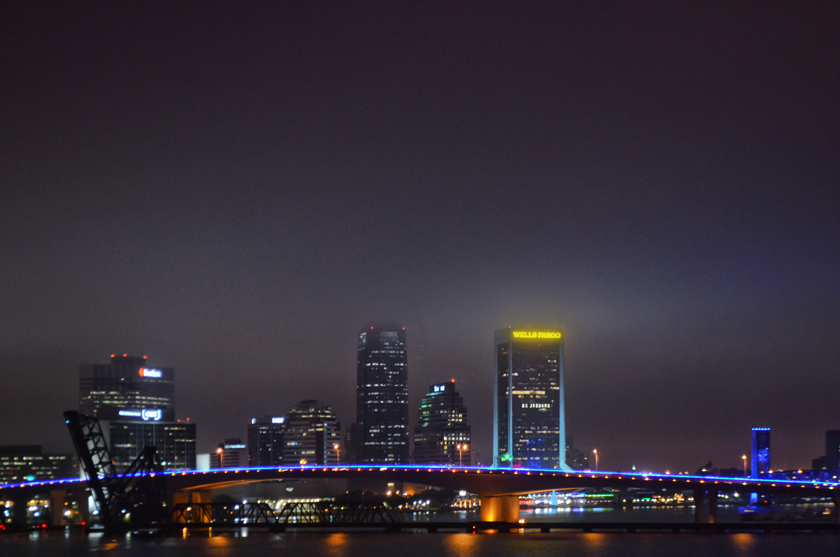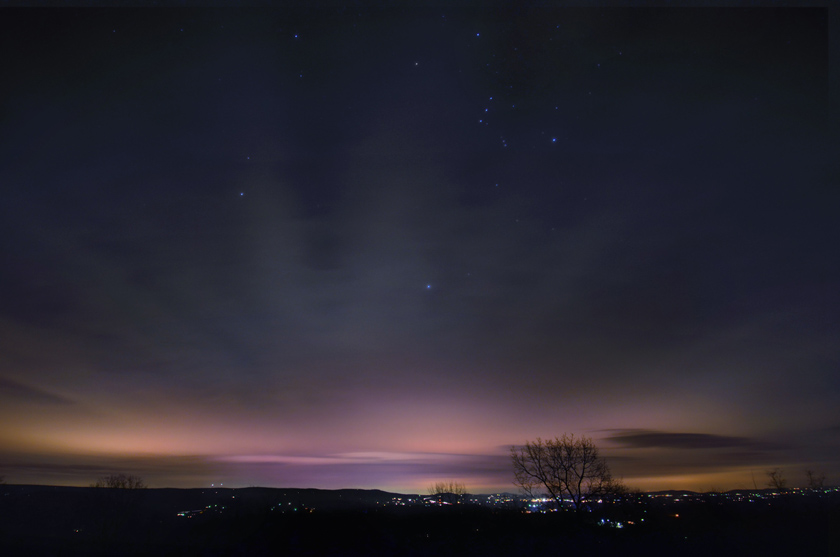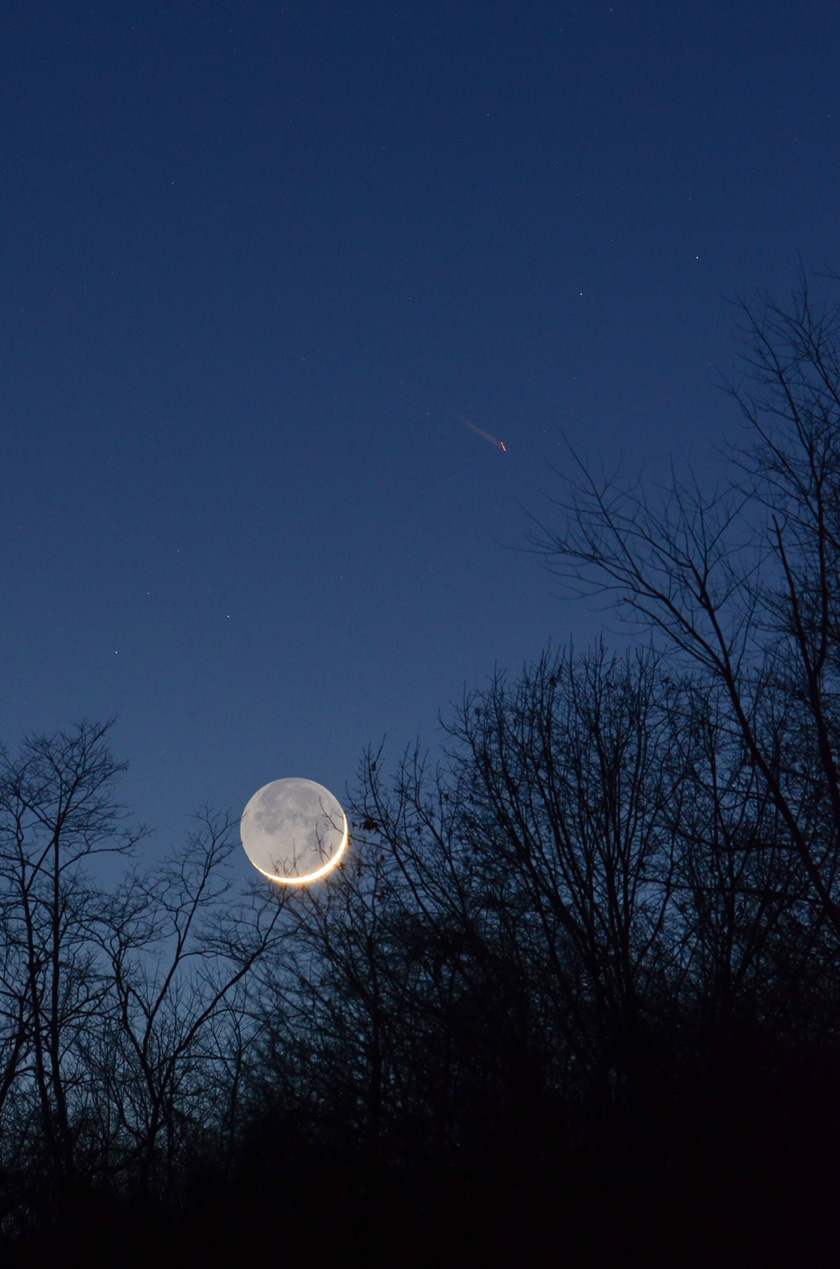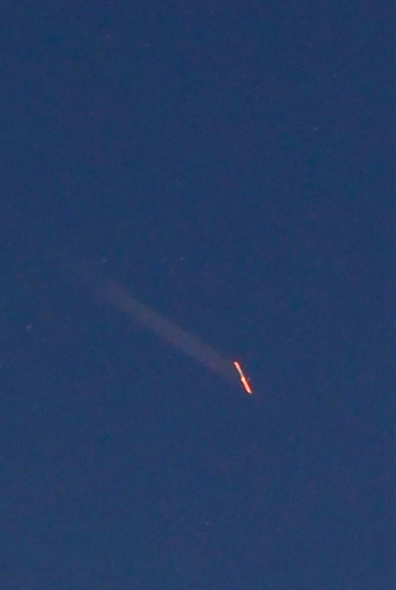Every so often I’m stopped in my tracks by seeing something a little bit, or sometimes very much, differently from how I’m accustomed to seeing it. Lately this has happened a few times after dark, and the most recent time it produced such a surprise I had to share it here. Below are three photos from my last week. You can find the story on each of them below the photos.



The first photo above was taken while I was driving my mother to Florida for the winter. It’s our yearly ritual; I get her settled and fly back to Maryland. Due to our schedule this year we happened to be driving though Jacksonville in early evening rush hour. The big computerized signs over I-95 warned of a disabled truck and lane closure ahead, so traffic slowed to a stop-and-go pace.
Normally this would be a bummer. We happened to be on an elevated section directly across the water from the blue-lit Acosta Bridge over St. John’s River. It’s a lovely sight at night but one you normally can see only from a fast-moving car. This evening the sky was misty with light rain, creating a halo around everything. Suddenly traffic in the left lane by the center median was at a dead standstill. I grabbed my camera, jumped out and managed to set the ISO and bang off a string of exposures before a police car pulled up the median behind me. I jumped back in my car just in time to start rolling with the traffic again.
I was shooting hand-held over traffic in the northbound lane which included heavy trucks, and the roadway was shaking the whole time. I had set the ISO and aperture before feeling the vibrations – even a tripod would have been useless for sharpening the image. Still I came away with a good if not perfect photo, from a vantage point not likely to be used by many other photographers. I would love to take a perfect photo someday from the same perspective, but that probably would require a gyroscopic stabilizer and permission from the Florida Highway Department.
Second photo – after arriving back in Maryland I was anticipating the arrival of the Geminid meteor shower, checking the weather every evening. On early Wednesday the skies weren’t too clear, but the high clouds stretching east toward the lights of Middletown and Frederick allowed Orion to show as if through gossamer, and gave the scene a dreamlike quality resembling the Aurora Borealis.
The International Space Station
Finally, on Friday coming up my drive at twilight I was struck by the ethereal beauty of the crescent moon. As it was setting the dark part of it was illuminated by earthshine. It was already dropping behind the trees so I had to work fast. I grabbed my tripod and made a series of exposures, walking around a bit to evade the treeline.
I noticed a moving bright spot that I first thought was a plane. I nearly waited until it disappeared so it wouldn’t be a distraction, but the moon was setting too fast so I kept shooting. It was only after I loaded the pictures into my computer and viewed them at full size that I realized what that bright spot was. At first I could hardly believe my eyes, but then went to the Internet and found I had been shooting exactly in the 4-minute window of visibility for the International Space Station at my geographic location.
There’s an element of dumb luck about this photo, but there’s also an element of preparedness I can take credit for. It’s a technically perfect shot – I had not only the instincts but the ingrained habit to make the most of the scene and was rewarded for it in spades. I used a prime lens: my old 180mm Nikkor-ED, a superbly sharp lens at all apertures but especially that sweet spot of f 5.6. I also used a remote release with mirror lockup before each exposure, which nulled out all camera vibrations. It is a pin-sharp image. And finally with Adobe Lightroom I was able to reduce noise in the photo to nearly nothing.
Here’s a detail enlargement of the space station; the color is created by the refraction of sunlight by its solar panels’ angle to the sun, which was changing by the second.

A few incidental facts – the International Space Station is 290 feet wide and 356 feet long – big enough to be seen even at its altitude of 230 miles. It moves over the earth at somewhat over 17,000 miles per hour. You can find when it may be seen from any location using the link at bottom.
Technical data: Nikon D7000, ISO 800, 180 Nikkor-ED lens @ 5.6, exposure 1.3 second.
What a blessing: Right place, right time… Absolutely amazing photography, as always, Dennis.